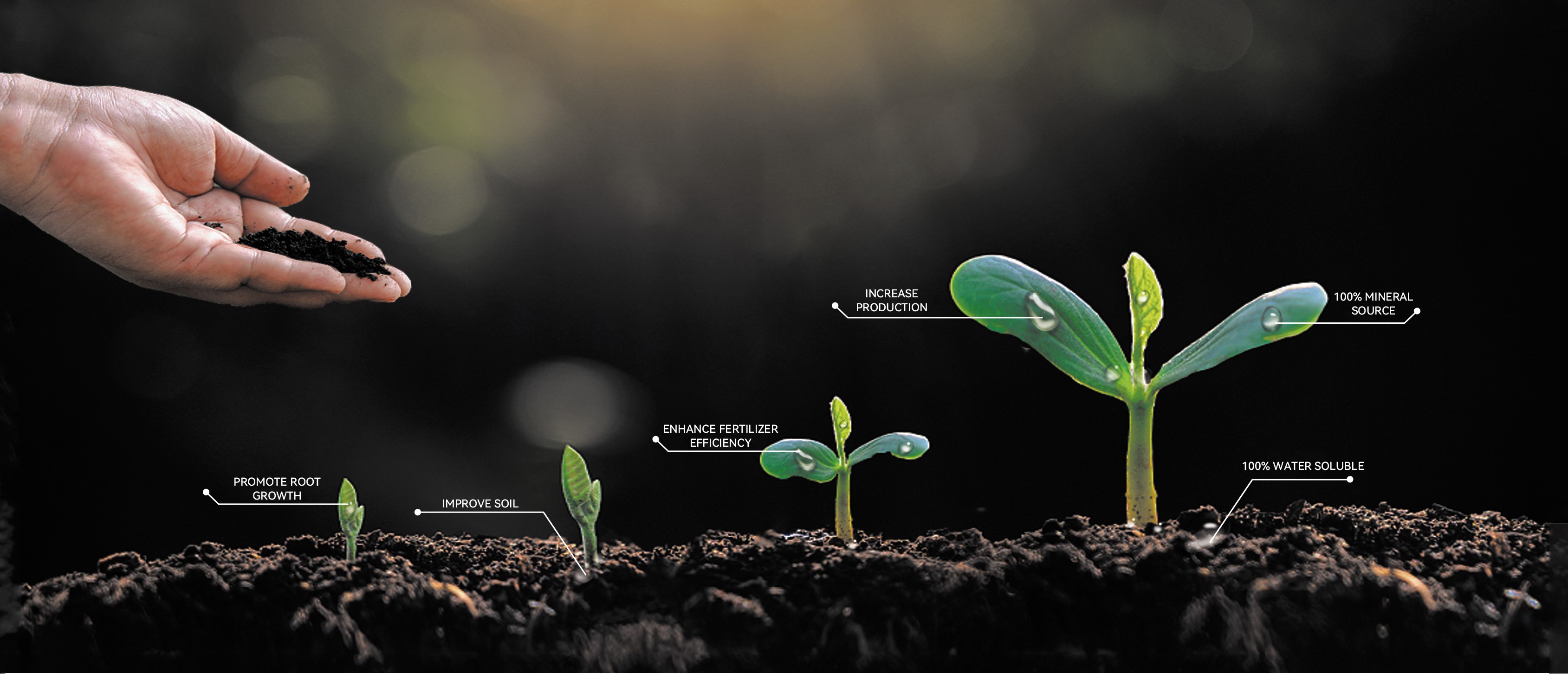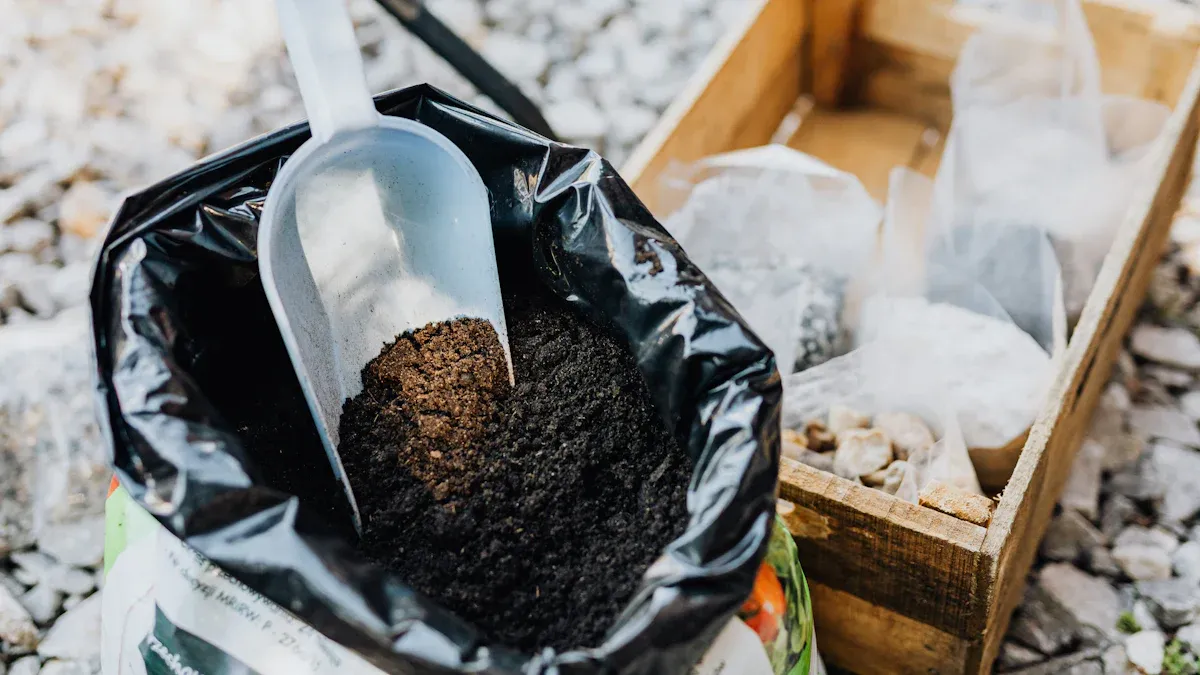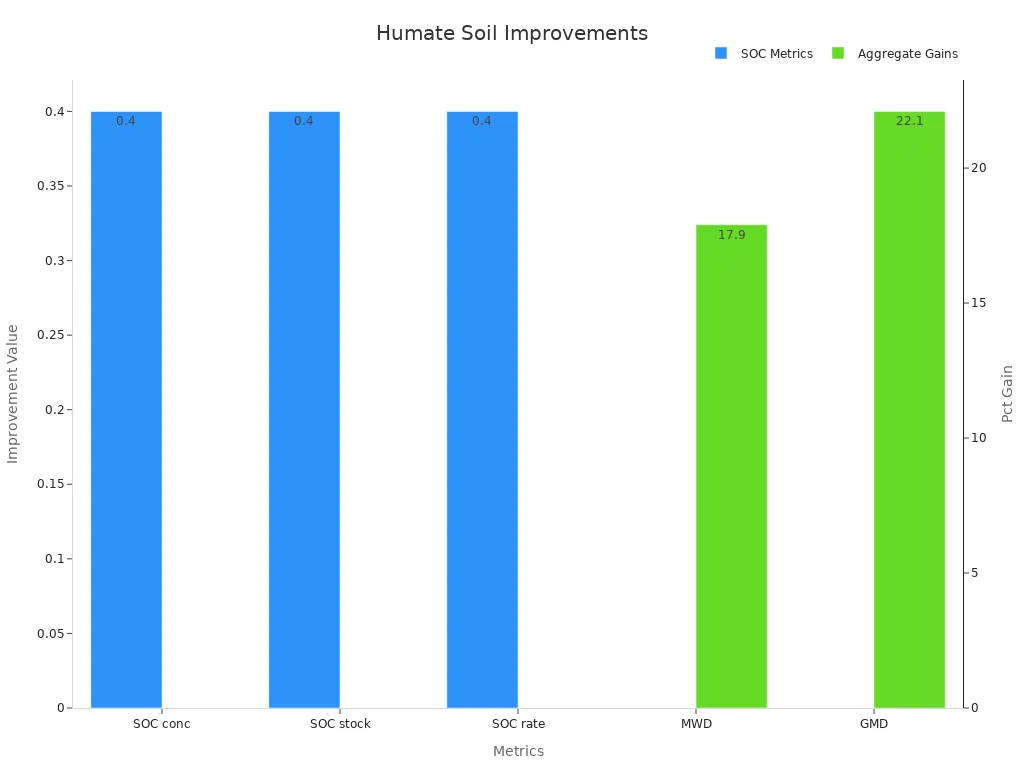What Is Humate Use and Why Does It Matter

Humate use means putting natural soil helpers called humates in your soil. Humates help you grow stronger plants and grass. They do this by making the soil better, helping roots grow, and letting roots take in nutrients more easily. Studies show humates can make roots weigh up to 65% more. They can also make the whole plant weigh up to 21% more than just using fertilizer.
Gardeners, farmers, and people who care for grass see greener grass for longer. They need less fertilizer and see more earthworms after using humates. You can look at the results in this table:
Aspect | Numerical Evidence | Benefit Description |
|---|---|---|
Duration of Greener Grass | Extra 2 months | Treated grass stayed greener longer |
Soil pH Improvement | Reached 6.8 within 1 year | Healthier soil conditions |
Fertilization Frequency | Reduced to 2 times per year | Less fertilizer needed |
Soil Health Indicators | Increased microbial activity, more earthworms | Better nutrient retention and drought resistance |
Key Takeaways
Humates are natural soil helpers. They make soil healthier. They help plants grow stronger and look greener. Using humates helps roots grow bigger. Plants can take in nutrients better. You do not need as much extra fertilizer. Humates make soil clump together better. The soil can hold more water. They help good microbes and earthworms live in the soil. Use humates at the right time and in the right way. You can mix them with fertilizers. You can also water after using them. This gives the best results. Humates help lawns stay green for a longer time. They lower plant stress. Plants grow healthier with less chemicals.
What Are Humates
Humates are natural things made when old plants and animals break down. You can find them in soil, peat, and some coal like leonardite. Scientists say humates are salts or esters of humic acid. These materials take thousands of years to form as organic matter rots. When you put humates in your soil, your plants get strong natural helpers. These helpers make the soil better and help plants grow healthy.
Types of Humates
There are different types of humates, and each one is special. The main types are humic acids, fulvic acids, and ulmic acids. They are not the same in size, how they dissolve, or how they help plants.
Classification | Molecular Weight (Da) | Solubility | Functional Role |
|---|---|---|---|
Humic Acids | 50,000 to 100,000 | Soluble in water under alkaline conditions | Bind nutrients and metals, making them easier for plants and microbes to use. |
Fulvic Acids | 5,000 to 10,000 | Water soluble at all pH levels | Carry trace minerals directly into plant cells for fast nutrition. |
Ulmic Acids | N/A | Part of humate composition | Support soil structure and are part of the overall humate mix. |
Humic acid is the type most used by farmers. You see it a lot in organic fertilizers and soil boosters. Fulvic acid is smaller and can get into plant parts more easily. Ulmic acid is not as famous but still helps the soil.
How Humates Work
When you add humates, they help in many ways. First, humates grab onto nutrients and minerals in the soil. This keeps nutrients from washing away and makes them easy for roots to use. Scientists found humic substances can make both water-soluble and solid mixes with metals and minerals. This helps plants get what they need, even if the soil is not great.
Humates also act like plant hormones. They help roots grow and let plants take in more water and food. Tests show humates make roots bigger, leaves grow more, and roots change shape. Humates help good soil microbes work harder. These microbes break down old plant stuff and give out more nutrients. Studies show humates raise soil organic carbon and help good microbes grow. This makes soil healthier and plants stronger.
Tip: Humates help your soil keep more water and nutrients. This makes your garden or lawn stronger when it is dry. 🌱
Benefits of Humate Use

Soil Health
Humate use can make your soil much better. When you add humates, soil pieces stick together more. This forms bigger clumps called aggregates. These clumps make the soil loose and easy for roots. Humic acid helps make more big soil clumps. It also makes the soil stronger and less likely to break apart. Soil with humates holds more water and air. This helps roots get what they need to grow well.
Humates raise the amount of organic carbon in soil. This lets the soil store more nutrients. It also feeds good microbes that help plants. In tests, soil organic carbon went from 6.9 g/kg to 7.3 g/kg after using humates. The soil could also hold more nutrients. There was a 17.2% increase in cation exchange capacity. These changes help plants get more food from the soil.

Humates also help balance soil pH. If soil is too acidic or too alkaline, plants have trouble. Humates help keep pH steady. This makes it easier for roots to take in nutrients. Humates also help soil keep water longer after rain or watering.
Note: Humates feed soil microbes and earthworms. These helpers break down old plant matter and give nutrients to plants.
You can see these good changes in all kinds of soil. Humates make sandy and clay soils better. They also help good soils stay healthy for a long time.
Plant Growth
Humates help plants grow faster and stronger. They help roots take in more nutrients like nitrogen, phosphorus, and potassium. Roots also grow deeper and thicker with humates. Research shows wheat, maize, and other crops grow bigger with humates. Wheat with humic acid had more growth and more nutrients in its leaves.
Here is a table that shows how humates help plants:
Study / Author(s) | Key Findings on Humate Benefits | Plant/Crop | Soil/Condition | Notes |
|---|---|---|---|---|
Khan et al. (2018) | Humic acid improved growth and nutrient status | Wheat | Two soil types | Enhanced nutrient uptake and growth |
Khaled & Fawy (2011) | Improved nutrient content, plant growth, and soil properties | N/A | Saline soil | Helped plants under salt stress |
Delfine et al. (2005) | Increased growth and yield with foliar humic acid | Durum wheat | N/A | Positive effect on yield and growth |
Çelik et al. (2011) | Increased dry weight and mineral uptake with foliar humic acid | Maize | Calcareous soil | Enhanced nutrient uptake and biomass |
Singaram et al. | Increased soil total nitrogen by ~28-29% | N/A | N/A | More nitrogen in soil |
Han et al. | Enhanced phosphorus uptake in plants | N/A | N/A | Improved P availability and uptake |
Du et al. | Increased water- and acid-extracted phosphorus in soil | N/A | N/A | More available phosphorus |
Liu et al. | Increased potassium fixation and availability | N/A | N/A | More potassium for plants |
Saruhan et al. | Fulvic acids enhanced growth and mineral uptake in maize | Maize | N/A | Positive effects on growth and nutrient uptake |
Humates also help plants handle stress better. Plants can deal with drought, salty soil, and disease more easily. Humates act like plant hormones and help roots and shoots grow faster. Some studies show plants with humates had up to 10 times more root mass. Leaves also had more chlorophyll, so plants looked greener and healthier.
Tip: Humates help plants use fertilizers better. You can use less fertilizer and still get great results.
Lawns and Turf
If you care for a lawn or sports field, humates help grass grow greener and thicker. Humates help grass roots grow deeper. This keeps lawns green even when it is dry. Humates also help break down thatch, which is dead grass that can hurt your lawn.
Studies show lawns with humates have more grass and better color. If you use humates with amino acids, results are even better. Grass takes in more nutrients, like nitrogen and iron. This makes grass greener and healthier. In one study, lawns with humates had less disease. There was an 8% drop in snow mold and a 12% drop in brown spot.
Humates also help the soil under your lawn. They make soil structure better. Water soaks in more easily and roots can spread out. You will see more earthworms and good microbes. These keep your lawn healthy without needing extra chemicals.
Callout: Humates help you care for your lawn in a better way. You get a nice lawn with fewer chemicals and less water.
Using Humates
Application Methods
You can use humates in different ways. The way you use them depends on your needs and the product type. Liquid humates are good for spraying on leaves or using in irrigation. You can also mix them with starter fertilizers. Granular or powder humates work best when spread on top of soil or mixed in. Some products, can be used on leaves or in soil. You can mix humates with fertilizers or pesticides to help plants get more nutrients. This also helps the soil. Tests show putting humates in soil at 3 kg/ha gives the best crop yields. This works well for wheat, maize, and mungbean.
Tip: Mix humates with fertilizers for better results. Always check if they work well together first.
Timing and Frequency
Use humates at the right times for the best results. Many experts say to use raw humates in the fall. This gives them time to break down before spring planting. You can use liquid or granular humates at any plant stage. Early use helps roots grow and take in nutrients. For lawns, spring and fall are the best times. Always water after using humates so they reach the roots. How much you use depends on your crop and soil. Leafy greens need 1-2 lbs per acre. Root crops may need 3-5 lbs per acre. Test your soil to find the right amount and not use too much.
Tips for Best Results
Pick the right humate for your soil and plants.
Keep humates dry and in closed containers.
Wear gloves and a mask when using powders or granules.
Check soil pH and keep it between 6.0 and 7.5.
Use humates with balanced fertilizers for better growth.
Do not mix humates with salty fertilizers unless you test them first.
Apply humates when plants are starting to grow or roots are forming.
Use soil tests to set how much humate to use and avoid burning plants.
Note: Not all humates are the same. Buy from trusted sellers and read labels for humic acid amount and where it comes from.
You can see real value in humate use for your soil and plants. When you add humates, you help your soil hold water, boost good microbes, and make roots stronger. Many reviews show humic acids improve soil structure, reduce erosion, and help plants fight stress. Gardeners, farmers, and turf managers all see greener growth and less need for chemicals. Try humate use in your routine to build healthier soil and stronger plants. For more tips, explore trusted soil health resources or talk with local experts.
FAQ
What is the best way to apply humates in my garden?
You can spread granular humates on the soil or mix liquid humates with water and spray them. Water your garden after applying. This helps humates reach the roots.
Can I use humates with other fertilizers?
Yes! You can mix humates with most fertilizers. Always check the label first. Some fertilizers with high salt may not work well with humates.
How soon will I see results after using humates?
You may notice greener plants and better soil within a few weeks. Some changes, like more earthworms or better root growth, take a few months.
Are humates safe for pets and kids?
Humates come from natural sources. Most products are safe for pets and children when used as directed. Keep bags closed and store them away from play areas.
